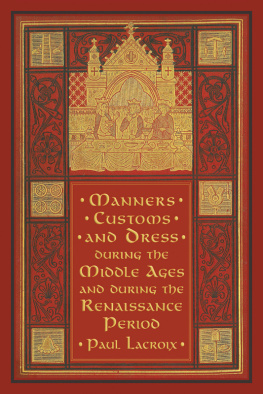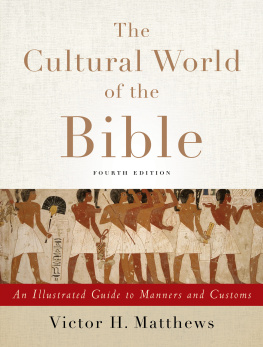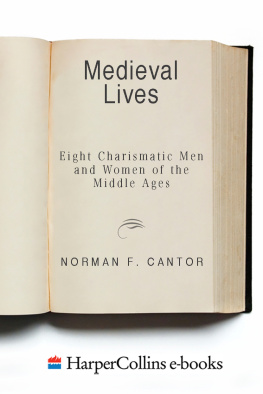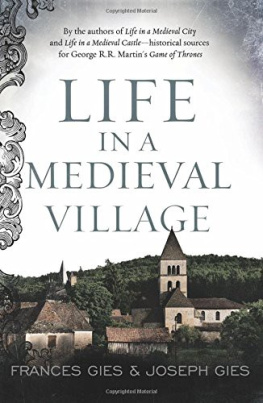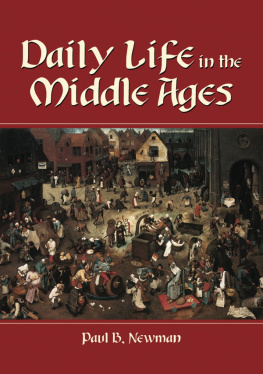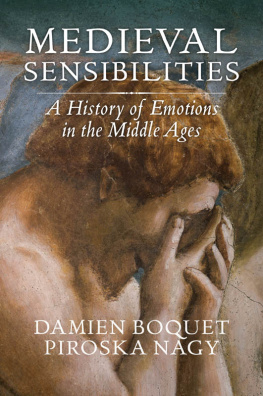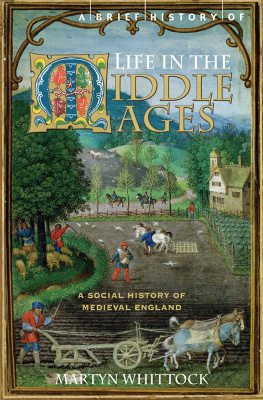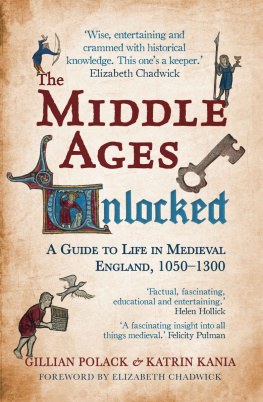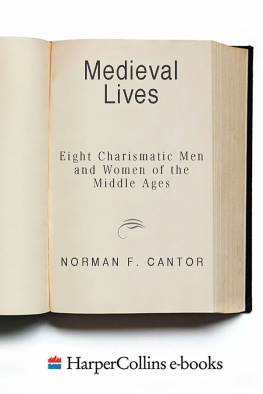MEDIEVAL
LIFE
MANNERS, CUSTOMS & DRESS
DURING THE MIDDLE AGES

PAUL LACROIX

Picture Credits
Front cover image courtesy of Corbis. For more information contact .

This edition published in 2011 by Arcturus Publishing Limited
26/27 Bickels Yard,
151153 Bermondsey Street
London SE1 3HA
Copyright 2011 Arcturus Publishing Limited
All rights reserved. No part of this publication may be reproduced, stored in a retrieval system, or transmitted, in any form or by any means, electronic, mechanical, photocopying, recording or otherwise, without prior written permission in accordance with the provisions of the Copyright Act 1956 (as amended). Any person or persons who do any unauthorised act in relation to this publication may be liable to criminal prosecution and civil claims for damages.
ISBN: 978-1-84858-518-8
INTRODUCTION
P aul Lacroix was born in Paris in 1806, the son of Jean-Louis Lacroix de Nir, a government tax official who was also a poet and novelist but who died when Paul was only seven.
Lacroix early showed a love of and scholarly interest in books, and while still at school he began to produce editions of old French classics such as the works of the poet Clment Marot and the novelist and satirist Franois Rabelais. But Lacroix not only edited the works of others, he was himself a writer, and at the age of nineteen, he presented several verse comedies at the Thtre de lOdon; they were well received, but he found the life of a dramatist distasteful and gave it up, as he did also writing for the popular press (where he was noted for his acute epigrams).
As well as drama, poetry and journalism, Lacroix wrote more than twenty historical romances. These met with some success, although his historical erudition may be said to have interfered to some extent with his work as a novelist, and he was mocked by the French writer Balzac for the learned material he included in his novels.
However, as one obituarist put it, his poetry, his novels, his plays have gone where the old moons and the old novels go. It is not for his literary works that Paul Lacroix is remembered today but for his scholarly writings on bibliography and history. His output was prodigious, much of it written under the pseudonyms P. L. Jacob, bibliophile and Bibliophile Jacob. Among his bibliographical works may be mentioned his Bibliographie moliresque and Iconographie moliresque (he was an authority on the 17th-century French dramatist Molire), his Dissertations bibliographiques and his nigmes et dcouvertes bibliographiques (Bibliographical Puzzles and Discoveries). He wrote a number of books of curious facts, such as Curiosits de lhistoire des arts (Curiosities from the History of the Arts), Curiosits de lhistoire du vieux Paris and Curiosits des sciences occultes. He also wrote more serious works on history, among which were a history of the emperor Napoleon III and one on the life and times of Tsar Nicholas I. Other interesting works from his pen include a study of the origins of playing-cards and an Histoire de la prostitution written under the name of Pierre Dufour. For his Histoire du seizime sicle (History of the Sixteenth Century), he was awarded the cross of the Legion of Honour at the age of only twenty-eight.
For his knowledge of French history, Lacroix was nominated a member of the history committees of the Ministry of Public Education and had an active role in many of the publications which were produced under their auspices. He also participated in the work of a commission on historical monuments set up by the Ministry of the Interior.
Lacroixs work as a library cataloguer is also worthy of note: his catalogue of the library of the book-collector Alexandre Martineau de Soleinne, for example, has been praised as a model of the art of cataloguing and is said to have influenced the thinking of the American librarian Melvil Dewey with regard to his library classification system. In 1855, he was appointed librarian of the Bibliothque Impriale de lArsenal (the Arsenal Library) in Paris.
Paul Lacroix died in Paris in October 1884.
Jointly with Ferdinand Sr and a number of other scholars, writers and artists, Lacroix had produced in 1847 Le Moyen ge et la Renaissance (The Middle Ages and the Renaissance), a detailed and highly illustrated five-volume study of the customs, arts, science and literature of that period. It was immensely successful and rapidly became a standard work; as Lacroix himself said: il est devenu clbre (it became famous). Some twenty or so years later, Lacroix decided that it would be appropriate to reproduce this material in a simpler form that would appeal to a wider readership, and in 1869 appeared his Arts au Moyen ge et lpoque de la Renaissance (soon after published in English as The Arts in the Middle Ages, and at the period of the Renaissance). Other similar books followed: Vie militaire et religieuse au Moyen ge et lpoque de la Renaissance (Military and religious life in the Middle Ages and at the period of the Renaissance), Sciences et lettres au Moyen ge et lpoque de la Renaissance (Science and literature in the Middle Ages and at the period of the Renaissance), and the work that is reproduced here, Moeurs, usages et costumes au Moyen ge et lepoque de la Renaissance (Manners, customs and dress during the Middle Ages, and during the Renaissance period).
The New York Times obituarist already quoted above has suggested that these big illustrated volumes belong to the region of the drawing-room table, but this is surely an underestimate of their value, as even the most cursory perusal of the text published here must show. While light and accessible in style, Medieval Life is far from being a mere coffee-table book, but is a work of great scholarship and a goldmine of knowledge, illustrating just about every aspect of life during the Middle Ages and the Renaissance commerce and finance, private lives and pastimes, justice and punishments, food and hunting, cultural customs and costumes, and much, much more both in France and across Europe. Part of the charm of the book lies, of course, in its more than 400 woodcut illustrations, taken from a variety of sources and many showing a nave simplicity of style typical of the medieval period but which are nonetheless useful sources of information in themselves and valuable accompaniments to the text. Mention must also be made of the nineteen prints by the Belgian artist Franz Kellerhoven, who, as Lacroix notes in his Preface, had quite recently found means of reproducing with so much fidelity the gems of Italian painting.
Charmingly antiquarian, Medieval Life is a piece of history preserved in print, a classic of historical study, and this beautiful facsimile collectors edition will appeal alike to historians and antiquarians, and to lovers of history and to lovers of fine books.
George Davidson
PREFACE.
T HE several successive editions of The Arts of the Middle Ages and Period of the Renaissance sufficiently testify to its appreciation by the public. The object of that work was to introduce the reader to a branch of learning to which access had hitherto appeared only permitted to the scientific. That attempt, which was a bold one, succeeded too well not to induce us to push our researches further. In fact, art alone cannot acquaint us entirely with an epoch. The arts, considered in their generality, are the true expressions of society. They tell us its tastes, its ideas, and its character. We thus spoke in the preface to our first work, and we find nothing to modify in this opinion. Art must be the faithful expression of a society, since it represents it by its works as it has created themundeniable witnesses of its spirit and manners for future generations. But it must be acknowledged that art is only the consequence of the ideas which it expresses; it is the fruit of civilisation, not its origin. To understand the Middle Ages and the Renaissance, it is necessary to go back to the source of its art, and to know the life of our fathers; these are two inseparable things, which entwine one another, and become complete one by the other.


